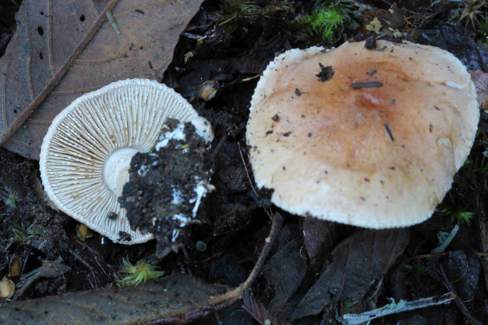 Hebeloma nothofagetorum (Photo: H. J. Beker)
Hebeloma nothofagetorum (Photo: H. J. Beker)Taxonomy
Full name: Hebeloma nothofagetorum B.J. Rees, Mycologia 105 (4): 1051 (2013)Genus: Hebeloma
Section: 'Mediorufa'
Types: AUSTRALIA: Tasmania: near Waldheim Chalet, Cradle Mountain, Cradle Mountain Nat Park (41.6358°S, 145.9492°E, alt. approx. 895 m a.s.l.) on soil under Nothofagus cunninghamii, 1 May 2005, R.E. Halling (Holotype. herbarium acc. no. HO 553022, HJB1000298).
- arrow_drop_downarrow_drop_upEtymology
- arrow_drop_downarrow_drop_upDiagnosisPileus 20–75 mm, circular, broadly umbonate, reflexed at the margin, which may be striate in older fruit bodies; color variable, warm ochraceous pink (5B3–7B3) with a deeper pinkish tan center (6C5–8D6); shiny, viscid (drier at the margin), surface easily peeled, generally glabrous, tomentose at the disk when dry; context cream white with a water-soaked line just above the lamellae; no obvious velar remains. Lamellae adnexed to sinuate, close, pinkish to pale coffee brown (5A3), thin, sometimes with clear fluid droplets at the whitish, fimbriate margin, 7 mm deep, two sets of lamellulae. Stipe 30–55 x 8–15 mm at the apex, tapering to 7–12 mm at the base, pruinose at the apex, longitudinally fibrillose throughout, darkening with handling, and with fine fibrils collecting spores throughout. No obvious velar remains. Flavor bitter. Odor not recorded. Spore print pale pink becoming dark brown on drying. Basidiospores [50/5/5] 9.7–12.8(–13.6) x (5.3–) 6.2–7.5 μm, Q = 1.51–1.73, inequilateral, elliptic to citriform, verrucose with a prominent perispore, and some thinning of the spore wall at the apex, fairly strongly dextrinoid (D3), perispore somewhat loosening in few spores (P1), spores with fairly strong ornamentation, always easy to see without oil immersion (O4). Basidia clavate, three- and four-spored, 33–43 x 9–11 μm, slightly swollen at the center with prominent sterigmata to 8 mm long. Cheilocystidia 30–60 x 8–14 μm, cylindrical with a prominent, at times abruptly capitate apex 10–13 μm wide that occasionally bifurcates to resemble large bone endings, also occasionally septate, slightly terminally thickened, hyaline. Pleurocystidia not observed. Caulocystidia consisting of occasional finger-like to broadly clavate endings present on long hyphal cells 2.5–3.5 μm wide, at stipe apex only. Pileipellis an ixocutis consisting of a surface layer of fine, slender, interwoven to collapsed, gelatinized, unclamped cells above a very narrow layer of slightly wider cells 3.5–4.0 mm wide, cells of the pileus trama more inflated and almost spherical, 10–30 μm diam.
References
Description
- arrow_drop_downarrow_drop_upThresholds
Description of Hebeloma nothofagetorum based on 22 collections
- arrow_drop_downarrow_drop_upMacroscopic descriptionPileus: (20) 35–57 (75) mm diameter; shape often convex or broadly umbonate, occasionally umbonate; characters occasionally remains of universal veil; margin characters usually scalloped, rarely crenulate, involute, reflexed or sulcate; viscosity tacky when moist; colour variation often two color, occasionally unicolour; colour at centre occasionally umber or cinnamon, rarely brick, yellowish brown or fawn.
Lamellae: attachment usually emarginate, occasionally adnexed; maximum depth 4–7 mm; number of complete lamellae 80–98; presence of tears often visible with naked eye, rarely absent or visible with x10 lens; white fimbriate edge present.
Cortina presence: no.
Stipe: (27) 29–59 (75) x 8–11 (15) {median} x (7) 9–13 (15) {basal} mm; stipe Q 2.7–8.3; base shape usually clavate, rarely tapering; floccosity usually floccose, occasionally fibrillose, rarely pruinose at apex; rooting no; thick rhizoids at base present;
Context: Texture firm; stipe interior hollow, occasionally superior wick; stipe flesh discolouring usually no, rarely yes; slenderness measure 1.6–8.4; smell usually odourless; taste often strongly bitter or mild where recorded.
Spore deposit colour: brownish olive.
Exsiccata characters: Not recorded.
- arrow_drop_downarrow_drop_upMicroscopic descriptionSpores: shape amygdaloid, occasionally limoniform; colour in microscope usually brown, occasionally yellow brown; guttules usually yes, occasionally no. papilla usually very strongly, occasionally yes; Spore Code: O4; P3; D3 D4.
Basidia: 24–35 (36) x 6–9 μm; ave. Q 3.6–4.3; spore arrangement 4 spored;
Cheilocystidia: main shape capitate-stipitate or clavate-stipitate, rarely spathulate-stipitate; special features observed often clamped septa, septa, branching or apical thickening, occasionally many collapsed in exsiccata, rarely bifurcate, conglutinate or irregular; cheilocystidia ratios: A/M = 1.95–2.64; A/B = 2.12–2.97; B/M = 0.89–1.08.
Pleurocystidia: none seen.
Ixocutis: epicutis thickness (measured from exsiccata) up to 125 μm; ixocutis hyphae width up to 8 μm; ixocutis hyphae encrustation variable; shape of trama elements beneath subcutis often cylindrical, isodiametric or thickly sausage-shaped up to 15 μm wide.
Caulocystidia: Similar to cheilocystidia but larger, up to 100 μm.
- arrow_drop_downarrow_drop_upSpore measurements
- arrow_drop_downarrow_drop_upCheilocystidia measurements
- arrow_drop_downarrow_drop_upHabitat and distributionHebeloma nothofagetorum's preferred habitat appears to be woodland pathside with mossy soil, soil or boggy soil. Where only one possible associate was recorded, the most commonly recorded associate was Nothofagus (85.7%) but Pomaderris (14.3%) were also recorded. In these cases the most commonly recorded families were Nothofagaceae (85.7%) and Rhamnaceae (14.3%). We have additional records where Eucalyptus (55.6%) and Acacia (5.6%) were recorded as possible associates, but in these cases a number of possible associates were mentioned. Overall the most commonly recorded families are Rhamnaceae (55.6%), Myrtaceae (55.6%), Nothofagaceae (44.4%) and Mimosoideae (5.6%) The growth habit of our collections was often scattered and occasionally solitary.
According to our current collections, the species is found only in Australasia. On the continent, collections have been found only in the temperate broadleaf & mixed forests WWF biome The World Wildlife Fund (WWF) have divided the world into 867 terrestrial ecoregions. The ecoregion here is estimated by mapping from the GPS coordinates of the collection using data made available by Dinerstein et al (2017). Use this webtool to explore the ecoregions visually or see a full list of current ecoregions on Wikipedia. (Tasmanian temperate forests (63.6%) and Tasmanian Central Highland forests (18.2%) ecoregions). From collector information, it appears collections have been found in the 1.4 Forest – Temperate (88.2%) and 5.4 Wetlands (inland) – Bogs, marshes, swamps, fens, peatlands (11.8%) IUCN habitats We map from the collector's description of the habitat to the International Union for Conservation of Nature (IUCN)'s definition using a standardised set of rules. Please see this page for a full list of IUCN habitats.. Within Australasia all our records are from Australia (Tasmania and Victoria).
Geographic distribution
Phenology
- arrow_drop_downarrow_drop_upAdditional cited collections